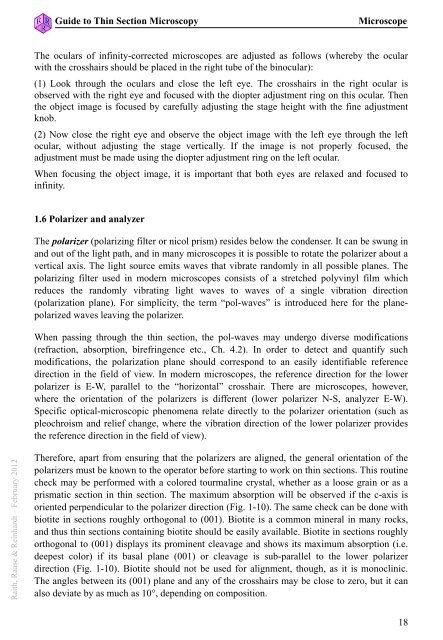guide to thin section microscopy - Mineralogical Society of America
guide to thin section microscopy - Mineralogical Society of America
guide to thin section microscopy - Mineralogical Society of America
Create successful ePaper yourself
Turn your PDF publications into a flip-book with our unique Google optimized e-Paper software.
Guide <strong>to</strong> Thin Section Microscopy<br />
Microscope<br />
The oculars <strong>of</strong> infinity-corrected microscopes are adjusted as follows (whereby the ocular<br />
with the crosshairs should be placed in the right tube <strong>of</strong> the binocular):<br />
(1) Look through the oculars and close the left eye. The crosshairs in the right ocular is<br />
observed with the right eye and focused with the diopter adjustment ring on this ocular. Then<br />
the object image is focused by carefully adjusting the stage height with the fine adjustment<br />
knob.<br />
(2) Now close the right eye and observe the object image with the left eye through the left<br />
ocular, without adjusting the stage vertically. If the image is not properly focused, the<br />
adjustment must be made using the diopter adjustment ring on the left ocular.<br />
When focusing the object image, it is important that both eyes are relaxed and focused <strong>to</strong><br />
infinity.<br />
1.6 Polarizer and analyzer<br />
The polarizer (polarizing filter or nicol prism) resides below the condenser. It can be swung in<br />
and out <strong>of</strong> the light path, and in many microscopes it is possible <strong>to</strong> rotate the polarizer about a<br />
vertical axis. The light source emits waves that vibrate randomly in all possible planes. The<br />
polarizing filter used in modern microscopes consists <strong>of</strong> a stretched polyvinyl film which<br />
reduces the randomly vibrating light waves <strong>to</strong> waves <strong>of</strong> a single vibration direction<br />
(polarization plane). For simplicity, the term “pol-waves” is introduced here for the planepolarized<br />
waves leaving the polarizer.<br />
When passing through the <strong>thin</strong> <strong>section</strong>, the pol-waves may undergo diverse modifications<br />
(refraction, absorption, birefringence etc., Ch. 4.2). In order <strong>to</strong> detect and quantify such<br />
modifications, the polarization plane should correspond <strong>to</strong> an easily identifiable reference<br />
direction in the field <strong>of</strong> view. In modern microscopes, the reference direction for the lower<br />
polarizer is E-W, parallel <strong>to</strong> the “horizontal” crosshair. There are microscopes, however,<br />
where the orientation <strong>of</strong> the polarizers is different (lower polarizer N-S, analyzer E-W).<br />
Specific optical-microscopic phenomena relate directly <strong>to</strong> the polarizer orientation (such as<br />
pleochroism and relief change, where the vibration direction <strong>of</strong> the lower polarizer provides<br />
the reference direction in the field <strong>of</strong> view).<br />
Raith, Raase & Reinhardt – February 2012<br />
Therefore, apart from ensuring that the polarizers are aligned, the general orientation <strong>of</strong> the<br />
polarizers must be known <strong>to</strong> the opera<strong>to</strong>r before starting <strong>to</strong> work on <strong>thin</strong> <strong>section</strong>s. This routine<br />
check may be performed with a colored <strong>to</strong>urmaline crystal, whether as a loose grain or as a<br />
prismatic <strong>section</strong> in <strong>thin</strong> <strong>section</strong>. The maximum absorption will be observed if the c-axis is<br />
oriented perpendicular <strong>to</strong> the polarizer direction (Fig. 1-10). The same check can be done with<br />
biotite in <strong>section</strong>s roughly orthogonal <strong>to</strong> (001). Biotite is a common mineral in many rocks,<br />
and thus <strong>thin</strong> <strong>section</strong>s containing biotite should be easily available. Biotite in <strong>section</strong>s roughly<br />
orthogonal <strong>to</strong> (001) displays its prominent cleavage and shows its maximum absorption (i.e.<br />
deepest color) if its basal plane (001) or cleavage is sub-parallel <strong>to</strong> the lower polarizer<br />
direction (Fig. 1-10). Biotite should not be used for alignment, though, as it is monoclinic.<br />
The angles between its (001) plane and any <strong>of</strong> the crosshairs may be close <strong>to</strong> zero, but it can<br />
also deviate by as much as 10°, depending on composition.<br />
18
















